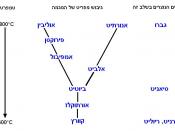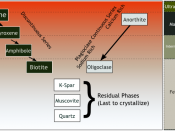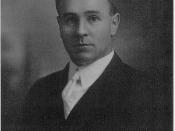Works Cited: Chernicoff & Fox Essentials of Geology, Ghaly Basic Geosciences
Illustrations For all Levels
The Bowen Reaction Series
In 1922, Norman Levi Bowen and his colleagues
determined the sequence in which silicate minerals
crystallize as magma cools (Chernicoff 56). This work made
it possible to summarize a complex set of geochemical
relationships, called Bowen's Reaction Series.
This series shows that silicate mineralscancrystallize
from mafic magmas in two
ways, in a discontinuous series or a continuous series.
Iron and magnesium rich silicates(ferromagnesian)
crystallize one after another in a specific sequence
(Chernicoff 56).
Because each successive type of this mineral
crystallized differs from the one that came
before it, this progression is called the discontinuous
series. In the discontinuous series the first
ferromagnesian mineral to crystallize is olivine. Olivine
has a low silica content and a relatively simple structure
of independent tetrahedra (Chernicoff 56).
At the same temperatures as the olivine and the
pyroxenes crystallize, so does the
calcium feldspar.
As these crystals continue to interact
with the remaining liquid, sodiumions from the liquid magma
replace the calcium ions in the calcium feldspar (Chernicoff
57). Eventually the crystals are completely converted to
sodium feldspar. Because one type of ion is being replaced
by a similar ion; the internal structure does not change.
This progression is called the continuous series
(Chernicoff 57).
After both minerals from the discontinuous series
and the continuous series have crystallized completely from
an initially mafic magma, less than 10% of the original
liquid remains (Chernicoff 57). Depending on its
composition, this liquid may now contain higher
concentrations of silica, potassium, and aluminum. In such
a case, potassium feldspar, potassium-aluminum mica, and
quartz are the last minerals to crystallize (Cherincoff 57).
Higher Temperature: Basic Magma
Olivine Anorthite
Bytownite
Pyroxene
Labradorite
Amphiboles Andesine
Oligoclase
Biotite Albite
Orthoclase
Muscovite
Quartz
Low Temp: Acidic Magma (Ghaly 21).


